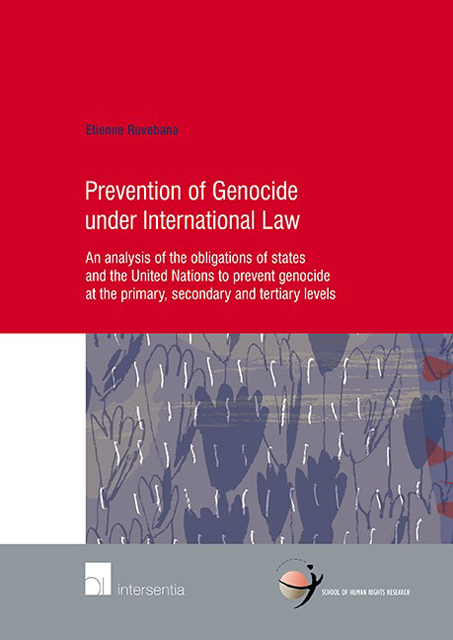 Prevention of Genocide Under International Law
Prevention of Genocide Under International Law Book contents
- Frontmatter
- Acknowledgements
- Contents
- List of Abbreviations
- Chapter I General Introduction
- Chapter II The Concept of Prevention as Understood in various Fields
- Chapter III The Concept of Prevention in the Field of Genocide in General
- Chapter IV Prevention of Genocide Under International Law
- Chapter V The Obligation of Territorial States to Prevent Genocide Under International Law
- Chapter VI Prevention of Genocide by Non-Territorial States Under International Law
- Chapter VII The United Nations and the Obligation to Prevent Genocide Under International Law
- Chapter VIII Prevention of Genocide and the Concept of the Responsibility to Protect
- Chapter IX Summary and General Conclusions
- Bibliography
- Samenvatting
- Curriculum Vitae
- School of Human Rights Research Series
Chapter VIII - Prevention of Genocide and the Concept of the Responsibility to Protect
Published online by Cambridge University Press: 24 November 2022
- Frontmatter
- Acknowledgements
- Contents
- List of Abbreviations
- Chapter I General Introduction
- Chapter II The Concept of Prevention as Understood in various Fields
- Chapter III The Concept of Prevention in the Field of Genocide in General
- Chapter IV Prevention of Genocide Under International Law
- Chapter V The Obligation of Territorial States to Prevent Genocide Under International Law
- Chapter VI Prevention of Genocide by Non-Territorial States Under International Law
- Chapter VII The United Nations and the Obligation to Prevent Genocide Under International Law
- Chapter VIII Prevention of Genocide and the Concept of the Responsibility to Protect
- Chapter IX Summary and General Conclusions
- Bibliography
- Samenvatting
- Curriculum Vitae
- School of Human Rights Research Series
Summary
INTRODUCTION
Many challenges have been identified in the three previous chapters with regard to the prevention of genocide by territorial states, non-territorial states and the UN. This chapter addresses the question whether and to what extent this relatively new concept is a (new) means to the prevention of genocide. It does not look at this concept from all perspectives nor does it enter in the whole debate that has surrounded its legality, legitimacy and implementation.
It proceeds in four sections. The first section gives a brief summary of the background and evolution of the concept of the responsibility to protect. While the second section considers the responsibility to protect by territorial states in comparison with the obligation to prevent genocide by territorial states at the three levels of prevention, the third section discusses the responsibility to protect by nonterritorial states and by the UN, in comparison with the obligation to prevent genocide by them at the three levels. The fourth and final section discusses thechallenges of the R2P vis-à-vis the prevention of genocide.
BACKGROUND AND EVOLUTION OF THE CONCEPT OF THE R2P
Given the manifest failure to prevent genocide in Rwanda and in Bosnia, the international community sought to build a new international consensus on how to respond in the face of massive violations of human rights and humanitarian law. The Canadian Prime Minister Jean Pierre Chrétien announced in the 2000 UN General Assembly the establishment of an International Commission on Intervention and State Sovereignty (ICISS). Launched in September 2000, the International Commission on Intervention and State Sovereignty (ICISS) was expected to come up with new ways of reconciling the seemingly irreconcilable notions of intervention and state sovereignty.
This commission came up with a new concept: the responsibility to protect (R2P). In explaining this concept, the commission noted that “the responsibility to protect means the “responsibility to prevent”, the “responsibility to react,” and the “responsibility to rebuild”. This concept was later referred to by the UN High- Panel on Threats, Challenges and Change in its report of 2004: A more Secure world: Our Shared Responsibility which emphasized that:
“sovereign governments have the primary responsibility to protect their own citizens from such catastrophes, when they are unable or unwilling to do so that responsibility should be taken up by the wider international community.”
- Type
- Chapter
- Information
- Prevention of Genocide Under International LawAn Analysis of the Obligations of States and the United Nations to Prevent Genocide at the Primary, Secondary and Tertiary Levels, pp. 289 - 316Publisher: IntersentiaPrint publication year: 2014
